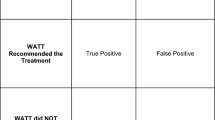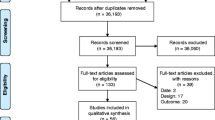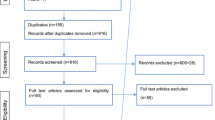Abstract
Purpose
Decisions to increase work participation must be informed and timely to improve return to work (RTW). The implementation of research into clinical practice relies on sophisticated yet practical approaches such as machine learning (ML). The objective of this study is to explore the evidence of machine learning in vocational rehabilitation and discuss the strengths and areas for improvement in the field.
Methods
We used the PRISMA guidelines and the Arksey and O’Malley framework. We searched Ovid Medline, CINAHL, and PsycINFO; with hand-searching and use of the Web of Science for the final articles. We included studies that are peer-reviewed, published within the last 10 years to consider contemporary material, implemented a form of “machine learning” or “learning health system”, undertaken in a vocational rehabilitation setting, and has employment as a specific outcome.
Results
12 studies were analyzed. The most commonly studied population was musculoskeletal injuries or health conditions. Most of the studies came from Europe and most were retrospective studies. The interventions were not always reported or specified. ML was used to identify different work-related variables that were predictive of return to work. However, ML approaches were varied and no standard or predominant ML approach was evident.
Conclusions
ML offers a potentially beneficial approach to identifying predictors of RTW. While ML uses a complex calculation and estimation, ML complements other elements of evidence-based practice such as the clinician’s expertise, the worker’s preference and values, and contextual factors around RTW in an efficient and timely manner.

Similar content being viewed by others
References
Ferdiana A, Post MWM, King N, Bultmann U, van der Klink JJL. Meaning and components of quality of life among individuals with spinal cord injury in Yogyakarta Province, Indonesia. Disabil Rehabil. 2018;40:1183–91. https://doi.org/10.1080/09638288.2017.1294204.
van Rijn RM, Carlier BE, Schuring M, Burdorf A. Work as treatment? The effectiveness of re-employment programmes for unemployed persons with severe mental health problems on health and quality of life: a systematic review and meta-analysis. Occup Environ Med. 2016;73:275–9. https://doi.org/10.1136/oemed-2015-103121.
World Health Organization. Rehabilitation. [cited 6 Sep 2022]. Available: https://www.who.int/news-room/fact-sheets/detail/rehabilitation.
Karcz K, Trezzini B, Escorpizo R, Finger ME. Factors associated with sustaining work with chronic spinal cord injury: a scoping review. Disabil Rehabil. 2022;44:7723–38. https://doi.org/10.1080/09638288.2021.1988736.
Hendriks SM, Spijker J, Licht CMM, Hardeveld F, de Graaf R, Batelaan NM, et al. Long-term work disability and absenteeism in anxiety and depressive disorders. J Affect Disord. 2015;178:121–30. https://doi.org/10.1016/j.jad.2015.03.004.
Ervasti J, Virtanen M, Pentti J, Lallukka T, Tinghög P, Kjeldgard L, et al. Work disability before and after diabetes diagnosis: a nationwide population-based register study in Sweden. Am J Public Health. 2015;105:e22–29. https://doi.org/10.2105/AJPH.2015.302646.
Escorpizo R, Reneman MF, Ekholm J, Fritz J, Krupa T, Marnetoft S-U, et al. A conceptual definition of vocational rehabilitation based on the ICF: building a shared global model. J Occup Rehabil. 2011;21:126–33. https://doi.org/10.1007/s10926-011-9292-6.
Milner A, Taouk Y, Disney G, Aitken Z, Rachele J, Kavanagh A. Employment predictors of exit from work among workers with disabilities: a survival analysis from the household income labour dynamics in Australia survey. PLoS ONE. 2018;13:e0208334. https://doi.org/10.1371/journal.pone.0208334.
Corbière M, Lecomte T, Reinharz D, Kirsh B, Goering P, Menear M, et al. Predictors of acquisition of competitive employment for people enrolled in supported employment programs. J Nerv Ment Dis. 2017;205:275–82. https://doi.org/10.1097/NMD.0000000000000612.
Bousfield K, Cheon J-Y, Harley S, Lampiris-Tremba A, Loseby J, Bianchi N, et al. What are the predictors of return to work for people with elbow, wrist, and hand conditions? A systematic review. J Occup Rehabil. 2021. https://doi.org/10.1007/s10926-021-09997-0.
Olsen L, Aisner D, McGinnis JM, Institute of Medicine (U.S.), editors. The learning healthcare system: workshop summary. Washington, DC: National Academies Press; 2007.
A Learning Health System Activity, Roundtable on Value and Science-Driven Health Care, Institute of Medicine. Observational Studies in a Learning Health System: Workshop Summary. Washington (DC): National Academies Press (US). ; 2013. Available: http://www.ncbi.nlm.nih.gov/books/NBK201315/.
Atkins D, Kilbourne AM, Shulkin D. Moving from Discovery to system-wide change: the role of research in a learning health care system: experience from three decades of health systems research in the Veterans Health Administration. Annu Rev Public Health. 2017;38:467–87. https://doi.org/10.1146/annurev-publhealth-031816-044255.
Friedman C, Rubin J, Brown J, Buntin M, Corn M, Etheredge L, et al. Toward a science of learning systems: a research agenda for the high-functioning learning health system. J Am Med Inform Assoc. 2015;22:43–50. https://doi.org/10.1136/amiajnl-2014-002977.
Place JF, Truchaud A, Ozawa K, Pardue H, Schnipelsky P. International Federation of Clinical Chemistry. Use of artificial intelligence in analytical systems for the clinical laboratory. IFCC Committee on Analytical Systems. Clin Chim Acta. 1994;231:5–34. https://doi.org/10.1016/0009-8981(94)90206-2.
Provost FJ, Hennessy DN. Distributed machine learning: scaling up with coarse-grained parallelism. Proc Int Conf Intell Syst Mol Biol. 1994;2:340–7.
Helm JM, Swiergosz AM, Haeberle HS, Karnuta JM, Schaffer JL, Krebs VE, et al. Machine learning and artificial intelligence: definitions, applications, and future directions. Curr Rev Musculoskelet Med. 2020;13:69–76. https://doi.org/10.1007/s12178-020-09600-8.
Bini SA, Artificial Intelligence M, Learning D, Learning, Computing C. What do these terms Mean and how will they Impact Health Care? J Arthroplast. 2018;33:2358–61. https://doi.org/10.1016/j.arth.2018.02.067.
Naylor CD. On the prospects for a (Deep) Learning Health Care System. JAMA. 2018;320:1099–100. https://doi.org/10.1001/jama.2018.11103.
Tricco AC, Lillie E, Zarin W, O’Brien KK, Colquhoun H, Levac D, et al. PRISMA extension for scoping reviews (PRISMA-ScR): checklist and explanation. Ann Intern Med. 2018;169:467–73. https://doi.org/10.7326/M18-0850.
Arksey H, O’Malley L. Scoping studies: towards a methodological framework. Int J Soc Res Methodol. 2005;8:19–32. https://doi.org/10.1080/1364557032000119616.
Manoli R, Chartaux-Danjou L, Delecroix H, Daveluy W, Torre F, Moroni C. Machine learning modelling of neuropsychological performance could determine vocational training outcome after a brain injury: Case report. Ann Phys Rehabil Med. 2021;64:101377. https://doi.org/10.1016/j.rehab.2020.01.009.
Hill A, Mann DR, Gellar J. Predicting program outcomes for vocational rehabilitation customers: a machine learning approach. JVR. 2022;56:107–21. https://doi.org/10.3233/JVR-221176.
Gross DP, Zhang J, Steenstra I, Barnsley S, Haws C, Amell T, et al. Development of a computer-based clinical decision support tool for selecting appropriate rehabilitation interventions for injured workers. J Occup Rehabil. 2013;23:597–609. https://doi.org/10.1007/s10926-013-9430-4.
Papić M, Brdar S, Papić V, Lončar-Turukalo T. Return to work after lumbar microdiscectomy - personalizing approach through predictive modeling. Stud Health Technol Inform. 2016;224:181–3.
Gross DP, Steenstra IA, Shaw W, Yousefi P, Bellinger C, Zaïane O. Validity of the Work Assessment Triage Tool for selecting rehabilitation interventions for workers’ compensation claimants with musculoskeletal conditions. J Occup Rehabil. 2020;30:318–30. https://doi.org/10.1007/s10926-019-09843-4.
Bai Z, Zhang J, Tang C, Wang L, Xia W, Qi Q, et al. Return-to-work predictions for Chinese patients with occupational upper extremity Injury: a prospective cohort study. Front Med. 2022;9:805230. https://doi.org/10.3389/fmed.2022.805230.
LoMartire R, Dahlström Ö, Björk M, Vixner L, Frumento P, Constan L, et al. Predictors of sickness absence in a clinical population with chronic pain. J Pain. 2021;22:1180–94. https://doi.org/10.1016/j.jpain.2021.03.145.
Manoli R, Chartaux-Danjou L, Delecroix H, Daveluy W, Torre F, Moroni C. The relationship between cognition and vocational training outcome in patients with acquired brain injury: contribution of machine learning. Appl Neuropsychology: Adult. 2022;29:212–22. https://doi.org/10.1080/23279095.2020.1734809.
Na K-S, Kim E. A machine learning-based predictive model of return to work after sick leave. J Occup Environ Med. 2019;61:e191–9. https://doi.org/10.1097/JOM.0000000000001567.
Lee J, Kim H-R. Prediction of return-to-original-work after an industrial accident using machine learning and comparison of techniques. J Korean Med Sci. 2018;33:e144. https://doi.org/10.3346/jkms.2018.33.e144.
Leighton SP, Krishnadas R, Chung K, Blair A, Brown S, Clark S et al. Predicting one-year outcome in first episode psychosis using machine learning. Acampora G, editor. PLoS ONE. 2019;14: e0212846. doi:https://doi.org/10.1371/journal.pone.0212846.
Linden A, Yarnold PR. Identifying causal mechanisms in health care interventions using classification tree analysis. J Eval Clin Pract. 2018;24:353–61. https://doi.org/10.1111/jep.12848.
Hill A, Mann DR, Gellar J. Predicting program outcomes for vocational rehabilitation customers: a machine learning approach. JVR. 2022;56:107–121. https://doi.org/10.3233/JVR-221176.
Sackett DL, Rosenberg WMC, Gray JAM, Haynes RB, Richardson WS. Evidence based medicine: what it is and what it isn’t. BMJ. 1996;312:71–2. https://doi.org/10.1136/bmj.312.7023.71.
Acknowledgements
GT was supported for this work by the Fulbright Foundation in Greece and the Fulbright program.
Funding
The authors declare that no funds, grants, or other support were received during the preparation of this manuscript.
Author information
Authors and Affiliations
Contributions
Reuben Escorpizo (RE) led the study’s conception and design. Material preparation, data collection, and analysis were performed by RE, Georgios Theotokatos (GT), and Carole A Tucker (CT). All authors participated in the writing of the manuscript. All authors read and approved the revised manuscript and its submission.
Corresponding author
Ethics declarations
Conflict of interest
All authors declare no conflict of interest.
Additional information
Publisher’s Note
Springer Nature remains neutral with regard to jurisdictional claims in published maps and institutional affiliations.
Appendices
Appendix A: PubMed
((“rehabilitation, vocational”[MeSH Terms] OR ((“work“[MeSH Terms] OR “work”[All Fields]) AND “rehabilitation”[MeSH Terms]) OR ((“occupant”[All Fields] OR “occupant s”[All Fields] OR “occupants”[All Fields] OR “occupational”[All Fields] OR “occupations”[MeSH Terms] OR “occupations”[All Fields] OR “occupation”[All Fields]) AND “rehabilitation”[MeSH Terms]) OR “return to work”[MeSH Terms] OR “employment”[MeSH Terms] OR “sick leave”[MeSH Terms] OR “work”[MeSH Terms] OR “absenteeism”[MeSH Terms]) AND “2012/07/19 00:00”:“3000/01/01 05:00”[Date - Publication] AND ((“learning health system”[MeSH Terms] OR “machine learning”[MeSH Terms]) AND “2012/07/19 00:00”:“3000/01/01 05:00”[Date - Publication])) AND (y_10[Filter])
Appendix B: CINAHL
(MH “Learning Health System”) OR (MH “Machine Learning+”) AND ((MH “Rehabilitation, Vocational+”) OR (MH “Job Re-entry”) OR (MH “Employment+”) OR (MH “Sick Leave”))
Appendix C: PsycInfo
((su(learning health system) OR su(machine learning)) AND PEER(yes)) AND ((su(vocational rehabilitation) OR su(occupational rehabilitation) OR su(work rehabilitation) OR su(return to work) OR su(sick leave) OR su(work) OR su(employment)) AND PEER(yes))
Rights and permissions
Springer Nature or its licensor (e.g. a society or other partner) holds exclusive rights to this article under a publishing agreement with the author(s) or other rightsholder(s); author self-archiving of the accepted manuscript version of this article is solely governed by the terms of such publishing agreement and applicable law.
About this article
Cite this article
Escorpizo, R., Theotokatos, G. & Tucker, C.A. A Scoping Review on the Use of Machine Learning in Return-to-Work Studies: Strengths and Weaknesses. J Occup Rehabil 34, 71–86 (2024). https://doi.org/10.1007/s10926-023-10127-1
Accepted:
Published:
Issue Date:
DOI: https://doi.org/10.1007/s10926-023-10127-1




